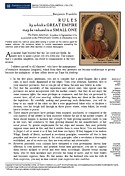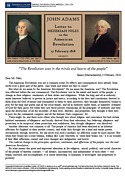CRISIS
9. How Did We Get Here?
- Benjamin Franklin, Rules by Which a Great Empire May Be Reduced to a Small One, satirical essay, 1773 PDF
- Francis Hopkinson, A Pretty Story Written in the Year of Our Lord 2774, allegory, 1774 PDF
- John Adams, letter to Hezekiah Niles, 1818, excerpts on the American Revolution PDF



David Ramsay, The History of the American Revolution, 1789
How did the colonists come to the brink of war in 1775? In 1763 they were celebrating military victory with Britain, and now, only twelve years later, were heading into a fateful war against Britain, long cherished as the Mother Country. Why did many turn from dutiful subjects to defiant Patriots? And why did many remain loyal to Britain and predict dire consequences of rebellion? When did resistance become rebellion, and when did rebellion become revolution? (And who's defining the terms?)
Here we view three perspectives on these questions from revolutionary leaders—men later deemed Founding Fathers. Two were written just before the outbreak of war, and one many years later. What do the men identify as crucial factors and pivot points in the road to revolution? Where do they place blame? honor? How do they justify the American rejection of imperial authority? (To these selections you might add the analyses by David Ramsay in his 1789 History of the American Revolution that appear in the compilations presented in this Theme.)
Benjamin Franklin, Rules by Which a Great Empire May Be Reduced to a Small One, 1773. While serving in Britain as an agent for several colonies, Franklin wrote numerous letters to London newspapers explaining the colonists' point of view to Britons, whose anger at Americans equaled Americans' rage at Britain. In this clever and prescient satire written two years before the outbreak of war, Franklin presents twenty "rules" for dismantling an empire—enrage the colonists till they are driven to revolt. Written as "guidelines" for the Prime Minister's cabinet (the ultimate villains to many Patriots), they comprise the most succinct review of the colonists' grievances. Franklin's satire is especially useful in the classroom for its elucidation of grievances beyond "taxation without representation," perhaps more accessible to students than Jefferson's list in the Declaration of Independence or the jargon-heavy lists in official petitions and declarations of the period. Have students begin by reading Franklin's italicized phrases at the end of each "rule," and proceed to an enlivened discussion of how "a great empire may be reduced to a small one." (5 pp.)
Francis Hopkinson, A Pretty Story Written in the Year of Our Lord 2774, allegory, 1774. Francis Hopkinson is known today chiefly as a signer of the Declaration of Independence and as the man who claims to have designed the nation's flag. During his lifetime, in addition to his political fame, he was also known as an author of patriotic songs, poems, pamphlets, and satires. A Pretty Story, published in 1774 when the First Continental Congress was meeting, employs allegory to recast the issues of the day into a simple domestic fable. In Chapter I, Hopkinson describes a nobleman [think the king] who ruled his valuable farm in such even-handed fashion that "his family was thought to be the best ordered of any in his neighborhood." This nobleman even issued a "Great Paper" [think Magna Carta] that gave his children a voice in how the family was governed. In Chapter II, we learn that the nobleman has come into possession of "an immense tract of wild uncultivated country at vast distance from his mansion house." Soon some of his "more stout and enterprising" children ask to settle this land. He gives them permission to do so and assures them that, though far away, they would always "be considered as the children of his family, and treated accordingly." With a clear understanding of mutual rights and responsibilities between them and their father, the children depart. The new country proves inhospitable, but eventually, "by dint of indefatigable perseverance," they carve out comfortable lives for themselves. Chapter III describes how relations between the nobleman and his distant children deteriorate, largely because his wife [think Parliament] has cast her avaricious eyes on the great wealth they have amassed. The allegory continues through four more brief chapters in which the nobleman, under the evil influence of his wife and her steward [think Prime Minister], violates the agreements he made with his distant children and even deprives them of the rights they possess under the "Great Paper." Eventually, the distant children become personified in a character named Jack [think John Hancock]. The story ends abruptly and unfinished with an irritated Jack contemplating how to resist the omnipotence of the nobleman's wife. This is not great literature, but, as an exercise in self-justification, it offers insight into how the colonists viewed themselves and their political situation one year before officially declaring independence from Britain. Questions and sidebars to guide identification of the allegorical allusions are included in the text. (Compare Hopkinson's Pretty Story with his similar allegory, "The New Roof," written in 1787 in support of the Constitution.) (10 pp.)
John Adams, letter to Hezekiah Niles, 1818, excerpts on the American Revolution. At age 83 Adams penned this well-known letter to Hezekiah Niles, a Baltimore newspaper editor born during the Revolution, as the men exchanged thoughts on the origins of the war. The Revolution began long before the outbreak of war, Adams begins, as British actions challenged then obliterated the allegiance of many Americans. The "radical change" in American loyalties occurred as Americans realized that Great Britain, like Lady Macbeth, would "dash their brains out" to assert its imperial dominance. Adams notes what is often true in the writing of history—that factors deemed essential by those who had lived through a historic era are overlooked in the later histories of the era. Don't focus just on individual leaders, he writes. Search out the "means and measures" of effecting revolutionary fervor among the people, not only to buttress history but to guide future revolutions (especially in South America) and to warn people of the "fiery trials and melancholy disasters they may have to encounter." Adams would live eight more years before he died, as did Thomas Jefferson, on the fiftieth anniversary of the Declaration of Independence. (2 pp.)
Discussion Questions
- How do these three documents clarify and/or complicate your view of the causes of the American Revolution?
- How does Franklin's Rules function as satire? as a warning? How do you think it was received in Britain in 1773?
- Compare Franklin's "rules" with the grievances listed in the Declaration of Independence. What factors does he emphasize as the causes of American rebellion? Does he place blame?
- In A Pretty Story, what factors does Hopkinson emphasize as the causes of the Revolution? Does he place blame?
- What does he see as the treachery and "harsh severity" of the king's officials?
- Why does Hopkinson abruptly end the story with the Latin phrase "Caetera desunt" ("the rest is missing")? How might readers have interpreted this ending in 1774?
- Compare the factors emphasized by Franklin and Hopkinson. On what do they agree? disagree?
- Why did Franklin resort to satire, and Hopkinson to allegory, to communicate their messages?
- Why are satire and allegory useful when composing political commentary in tumultuous times?
- In his 1818 letter, what does Adams cite as causing the "radical change" in American loyalties in the 1770s?
- What factors does Adams stress in 1818 that were less emphasized by Franklin and Hopkinson in the 1770s?
- What charge does Adams give to historians of the revolution? How does he see the American Revolution as a guide for 19th-century revolutions?
- If you were a historian searching through "all the records, pamphlets, newspapers, and even handbills" of the pre-revolutionary period, as recommended by Adams in his letter, what major questions would you take into your research?
- What questions would Franklin, Hopkinson, and Adams recommend, based on their writings in this section?
- Complete this chart on these documents by three Founding Fathers.
Benjamin Franklin Francis Hopkinson John Adams Document Rules by Which
a Great Empire May
Be Reduced to
a Small OneA Pretty Story,
Written in the Year
of Our Lord 1774letter to
Hezekiah NilesYear of Document 1773 1774 1818 Nature of document satirical essay for a London newspaper allegory published as a pamphlet in Virginia letter to the editor of Niles' Weekly Register
(Baltimore)Author's purpose in writing document One major cause of the Revolution Another major cause of the Revolution Could revolution have been avoided? Advice to future historians of the Revolution Advice to leaders of future revolutions [Topic of your choice]
Framing Questions
- Between 1763 and 1775, what changed many Americans from loyal British subjects to rebellious Patriots?
- Why did many Americans remain loyal to Great Britain and oppose rebellion?
- How did Patriots and Loyalists convey their views through the media outlets of the time?
- Was the American Revolution inevitable? If so, was there a "point of no return"?
Printing
Franklin, RulesHopkinson, A Pretty Story
Adams, letter
TOTAL
5 pp.
10 pp.
2 pp.
17 pp.
Supplemental Sites
- – The World in 1776 (Global Village)
- – The Road to Revolution (Q&A game)
The American Revolution, overviews and primary sources (American Memory, Library of Congress)
The Road to Revolution (American Revolution, Digital History, Gilder Lehrman Institute of American History et al.)
The Revolutionary War, primary documents (Gilder Lehrman Institute of American History)
"Was the American Revolution Inevitable?," not-to-miss teachable essay by Prof. Francis D. Cogliano, University of Edinburgh (BBC)
Teaching the Revolution, valuable overview essay by Prof. Carol Berkin, Baruch College (CUNY)
General Online Resources
Images:
– Benjamin Franklin, portrait by Joseph Siffred Duplessis, oil on canvas, 1778 (detail). Metropolitan Museum of Art, The Friedsam Collection, bequest of Michael Friedsam, 1931 (32.100.1232); reproduced by permission.
– Francis Hopkinson, self-portrait, pastel, after 1785 oil portrait by Robert Edge Pine, between 1787 and 1791, Maryland Historical Society; reproduced by permission.
– John Adams, portrait by Samuel Finley Breese Morse, oil on canvas, 1816. Brooklyn Museum of Art (32.144); reproduced by permission.
Banner image: Americans Throwing the Cargoes of the Tea Ships into the River, at Boston, engraving (detail), in W. D. Rev. Mr. Cooper, The History of North America (London: E. Newbery, 1789). Library of Congress, Prints & Photographs Division, LC-USZC4-538 (also Rare Book and Special Collections Division, Digital ID us0012_01). Courtesy of the Library of Congress.
*PDF file - You will need software on your computer that allows you to read and print Portable Document Format (PDF) files, such as Adobe Acrobat Reader. If you do not have this software, you may download it FREE from Adobe's Web site.



